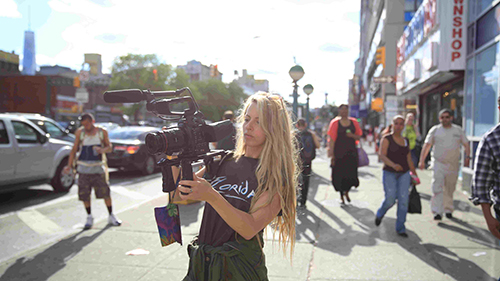Film Production
5 Basic Camera Movement Techniques that Every Cinematographer know
Without moving a camera, how you can make a Film? Camera movement is the integral part of movie making, the movement of the camera in a frame, is deciding by the filmmaker and the Cinematographer. Here in section, we are explaining about the five basic types of camera movements.
1. Tracking shot:
Tracking (also known as a dolly or Trucking Shot) is the commonly using camera movement in films. As the name implies, it is a tracking (Moving) shot, where the camera is fitted above a four wheel Platform (Usually rail and trolley) for moving the camera smoothly to the front and back. If the camera moves towards the subject (Performer), that movement is called as ‘Track In,’ similarly if the camera moves away (back) from the subject, it is called as ‘Track Back’ Shot.
Advantages:
- Can visualize the scenes without any shake
- Best For – Tracking shot ( Following an actor from the back or front), Landscape Establish ( Mounting a camera above the trolley in a horizontal position to focus capture a landscape)
Disadvantages:
- Set-up Installation Cost is High
- For this arrangement, You must have at least the manpower requirement of three (Key Grip, Focus Puller, Camera assistant)
2. Crane Shot
The Crane shots are generally used in filmmaking for getting the high angle views: also you can create establishing shots and tracking shots through this method. Some of the important cranes models that are used in the industry are Mini cranes (Below 40 feet), Garuda cranes and Gimmy jib cranes
Advantages
- Better For visualizing the establish scenes (opening scene of Movies )
- Common Tricks in this method are Crane Up ( raising the crane), Crane Down ( lowering the crane) and Crane Up/Crane down+ Tracking
Disadvantages:
- Cost is high, renting a normal crane will costs around $400 USD/Day
3. Tilting and Panning
Tilting- The camera mounted on a Tripod and it moves up (Tilt-up) and Down (Tilt Down) is called tilting. The tilting movement is found mostly practicable in POV shots. Let’s illustrate with an example, for an instance, there are two characters in a frame, where the 1st character is looking to 2nd character from down to up. Here you can use a ‘Tilt down’ shot, so that the audience can get a feel of the first character.
Panning- The camera mounted on a Tripod and it moves to left (Pan Left) and right (pan Right) is called panning. You can make a round circle (180 degree) shot by turning the camera from left to right (or) from right to left. The maximum frame rate that required for this smooth operation is 24 or 25 fps.
Advantages
- It is really an awesome Filmmaking technique for making great shots like panning and tilting, Zip Pan, Swish Pan, circle-shot etc.
Disadvantage
- Well training is required: if you fail to stabilize the speed camera movement, then it won’t gives you a good result
4. Hand- Held
We had already been discussed in previous chapters about the handheld-camera techniques and its practices. (See the references that are linked Below)
Click Here To Read the About Hand Held Filmmaking Tips and Techniques
Click here to read the acceptable facts of Hand Held Cinematography
Click here To read about the analysis of Hand Held Filmmaking
5. Steady Cam
In this typical type of camera movement, the cameraman fixes the camera in his body through a system called ‘Anti Vibration Mountings’ that helpful to reduce the camera shakes. Wide angle camera lenses are preferable in the Steady cam filmmaking technique.
Advantage
Comparing with the Hand Held movement, the steady cam camera movement are easier to use and it also produce good results.
Best For- creating the suspense shots, like one character is following other from behind
Disadvantage
Really, you can’t expect a good result without a pre-practical skill.
Thanks. For Reading: Poll Your opinion in the comment section Below
Now watch This Video Created by Curtis Brownjohn really worth to watch to know more about camera Movements
Follow us on Facebook!
Ask a Question. FilmmakersFans will respond to it within next few minutes. Try Now.



















































